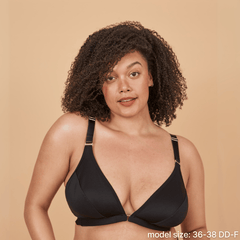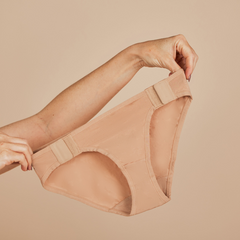Are you tired of ill-fitting bras that offer no support and make you feel uncomfortable? Look no further! In this ultimate guide, we will demystify the process of measuring bra size, so you can find the perfect fit and feel confident all day long.
Whether you're a seasoned bra shopper or new to the game, understanding how bra size is measured is essential for a comfortable and flattering fit. From understanding your band size to determining your cup size, we'll walk you through each step.
With our expert tips and insights, you'll be equipped with the knowledge to find the right bra size in any brand that enhances your shape and provides the necessary support. Get ready to be equipped with the knowledge to make the best purchasing decision for you and live more comfortably.
Understanding the Importance of Proper Bra Sizing

Proper bra sizing is more than just a matter of comfort; it can also have a significant impact on your overall health and well-being. Ill-fitting bras can lead to a range of problems, including back and shoulder pain, poor posture, and even stretch marks. By understanding how bra size is measured and ensuring you are wearing the correct size, you can avoid these issues and feel your best.
One common misconception about bra sizing is that there is one single answer. Women tend to believe they are one size, but in reality sizes change over a person’s lifetime because of life factors, such as hormonal changes, aging, periods, pregnancy, etc.
Different bra sizing systems can add to the confusion when it comes to finding the right size. Although there are a few common sizing systems, each brand or country may have their own. This means that if you’re a 36C in one brand, you may be a different size in another brand.
That’s why it's essential to always check a brand’s sizing chart and methodology before purchasing a bra.
Knowing your measurements and understanding the relationship between band and cup sizes is key to finding the perfect fit. This knowledge will help you navigate the world of bras and ensure you are purchasing your size in that brand.
Taking Accurate Measurements for Bra Size
To determine your bra size accurately, you'll need to take a few measurements. Start by measuring your underbust, which will give you your band size. Use a soft measuring tape and wrap it snugly around your ribcage, just below your breasts. Make sure the tape is parallel to the ground, breathe out, and then measure, so that the tape is not too tight or too loose.

Next, measure your bust size. Wrap the measuring tape around the fullest part of your breasts, making sure it is parallel to the ground. Be sure not to pull the tape too tight, as this can result in an inaccurate measurement.

One general recommendation if you have heavier breasts is to wear your best fitting bra (not bralette) while measuring the bust size, so that they are lifted. Make sure the bra is not a minimizer bra and that it doesn’t have padding or push up. If you don’t have such a bra and have pendulous breasts, you may want to lean at a 90* angle for measuring (if you can).
With these two measurements in hand, you're ready to calculate your bra size.
Determining Your Band Size
Your band size is relatively straightforward, but it does depend on the brand. Some brands use your exact measurement as the band size, but many add inches to it.
Depending on the brand, they may add 2-3 inches or 4-5 inches. This is where knowing your measurement will come in the most handy. Most companies will have a size chart that tell you what band size you are in their brand based on your measurements.
For Springrose, we use the following measurements to determine band size:

Determining Your Cup Size
Finding the right cup size can be a bit trickier. Many people think a cup size represents a specific breast size, but in reality, it’s all about the relationship between the underband and the cup. A cup is the difference between your bust measurement and your band size.
Cups are also about breast volume. That’s why a 44B will always have a larger cup than a 34B, even if they’re both B cups.
To find your cup size, subtract your band size from your bust size. Each inch of difference corresponds to a different cup size. A 1-inch difference is an A cup, a 2-inch difference is a B cup, and so on. See here:

For example, if your bust measurement is 38 inches and your band size is 36, the difference is 2 inches, which corresponds to a B cup.
It's important to note that cup sizes are not universal and can vary between different brands and countries. A B cup in one brand may be equivalent to a C cup in another brand. This is where understanding sister sizes can come in handy.
Sister sizes are bra sizes that have the same cup volume but different band sizes. Knowing your sister sizes can help you find the right fit, even if your exact size is not available.
Understanding Sister Sizes and Their Relevance
Sister sizes are a useful tool when it comes to finding the perfect fit. Let's say you try on a bra in your usual size, but the band feels too tight. Instead of giving up on the style you love, you can try going up a band size while going down a cup size. This is known as a sister size. The cup volume remains the same, but the band size is adjusted.
For example, if your usual size is 36C and the band feels too tight, you can try a 38B instead. The cup size is smaller to maintain the same volume, but the looser band provides a more comfortable fit. Keep in mind that sister sizes may not be available for all bras, so some trial and error may be necessary.
Exploring Different Styles

Each breast shape will have different bra styles that will be flattering to wear. By looking up online what others recommend or trying various options at a department store, you can better determine what suits you.
There are also adaptive bras on the market, which are designed specifically for people with limited mobility. They can have adaptations, such as a Velcro closure, that make them easier to put on than traditional bras with hook and eyes in the back.
Common Problems with Ill-Fitting Bras
Wearing the wrong bra size can lead to a range of problems that can affect your comfort, confidence, and overall well-being.
One common issue is cup gaping, where the cups of the bra do not sit flush against the breasts, resulting in a less flattering fit. Cup gaping can occur when the cup size is too large or the shape of the bra does not match the shape of your breasts.
There are many different breast shapes, so it’s completely normal if a bra doesn’t fit perfectly or in the most flattering way. Assess if it’s a big enough issue that it bothers you and whether you want to exchange or return the bra.
Another common problem is a band that feels too tight or too loose. A band that is too tight can result in discomfort, digging into your skin, and leaving marks. On the other hand, a band that is too loose may not provide the necessary support.
A good way of noting whether the band is at the appropriate tightness is by putting your fingers under the band. A well fitting bra should allow you to put two fingers under the band. If you can put fewer or more, then you might need to adjust the closure in the back.
Further, the band should not ride up your back. If it does, you can try adjusting the closure again. If this doesn’t solve the problem, then determine whether this is something that bothers you. If it does, particularly if you are larger chested, then you should change bras. If it doesn’t, then it doesn’t really matter.
Tips for Maintaining and Prolonging the Life of Your Bras

Now that you've found the perfect bra size, it's essential to take care of your bras to ensure they last as long as possible. One essential tip is to rotate your bras, wearing a different one each day. This allows the elastic to recover between wears, prolonging the lifespan of your bras. Avoid wearing the same bra two days in a row to give it time to regain its shape.
When it comes to washing your bras, it's best to hand wash them or use a lingerie bag in the washing machine on a gentle cycle. Avoid using harsh detergents or bleach, as these can damage the fabric and elastic. Instead, opt for a mild detergent specifically designed for delicate lingerie.
Conclusion: Finding the Right Bra Size
Finding the right bra size can be a game-changer. Not only will you experience increased comfort, but you'll also notice a boost in confidence. Wearing a bra that fits properly enhances your shape, provides the necessary support, and allows you to move with ease throughout the day.
By understanding how bra size is measured and taking accurate measurements, you can find the perfect fit. Don't be afraid to explore different sizing systems and sister sizes to broaden your options. And remember, proper bra sizing is not a one-time event; it's essential to regularly check your size as your body can change over time.



